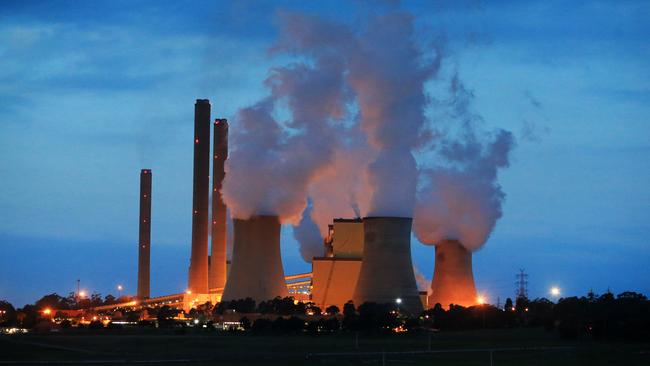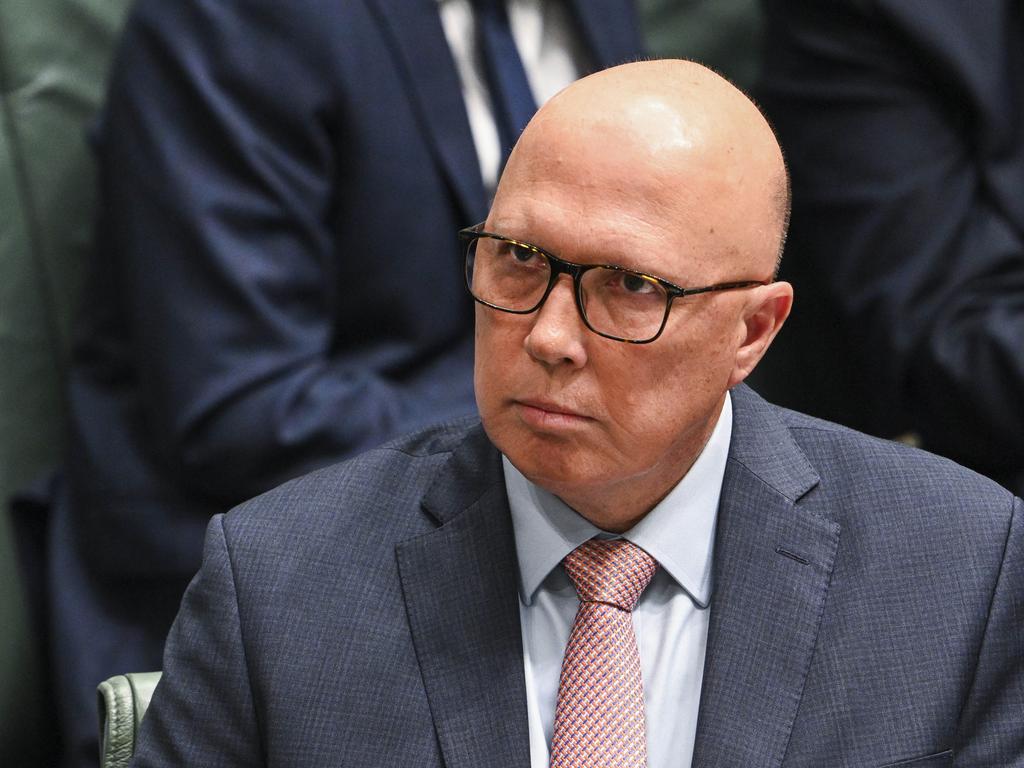Rival power plays over renewables and nuclear ignite energy wars
The ‘climate wars’ will be revived as Labor and the Coalition prepare radically different pathways to net-zero, with the PM promoting green jobs to woo working-class voters.

The climate wars are set to be revived as Labor and the Coalition prepare radically different pathways to reach net-zero emissions by 2050, with Anthony Albanese moving to win back working-class voters through funding for green jobs in seats dependent on fossil fuels.
With the Prime Minister to visit the NSW Hunter Valley on Friday to talk up renewables and critical minerals jobs in coal regions, Coalition MPs are calling for the life of coal-fired power stations to be extended until nuclear can be brought online in the 2030s.
“Reliable and affordable clean energy, from solar to green hydrogen to offshore wind can power a new generation of advanced manufacturing and heavy industry, in our suburbs and our regional centres,” Mr Albanese will tell Hunter business leaders.
The Prime Minister will promote the transformation of the old Liddell coal plant to a large-scale battery as a “snapshot of the economic and energy transformation underway in Australia”, while the Coalition is flagging it as a potential site for nuclear power generation.
Coalition MPs attacked Mr Albanese’s renewable plans and warned of mass blackouts, with new analysis showing about 16,000 megawatts out of the current 21,000MW coal fleet will be retired by 2040. The reduction in generation would be even larger under the Queensland government’s vow to close the Callide C power station by 2035, despite its natural life being more than 15 years longer.
Opposition energy spokesman Ted O’Brien, who is expected to release Mr Dutton’s energy policy within months, warned on Thursday that Labor’s renewables-only approach was a “road to ruin”.
The Coalition climate and energy policy, positioning nuclear energy as Australia’s long-term baseload power source to achieve net zero emissions by 2050, will be pitched as technologically agnostic and embrace a role for renewables.
Mr O’Brien said if Australia was open to nuclear, Liddell could be used to install four 300MW small modular reactors or one possibly 1.1GW larger reactor.
“Pushing 90 per cent of our baseload power out of the grid over the next decade will leave our nation poorer and weaker,” Mr O’Brien said.
“To turn off one system without having another ready to go is an act of extreme recklessness. As the weather becomes more volatile, Labor’s plan is to make the entire energy system weather dependent. It’s lunacy.
“Next-generation, zero-emissions nuclear energy is one of the safest forms of energy generation the world has ever seen. It produces zero emissions and is kind to the local environment with a tiny footprint.”
In a speech to the Hunter Nexus group in Newcastle on Friday, Mr Albanese will invoke the 1997 closure of the BHP steelworks in the city, which put 11,000 people out of work, as an example of how the Hunter region could diversify into new industries.
The Hunter, which has prospered for generations as one of Australia’s biggest coalmining hubs, pumps 6880MW into the national electricity market via the Bayswater, Eraring and Vales Point B coal-fired power plants. Labor holds four seats in the Hunter Valley, three of which the Coalition will target at the next election.
The Australian revealed last month the Albanese government was preparing clean-energy incentives ahead of the May 14 budget. In his speech, Mr Albanese will say that while the nation can’t match funding offered by bigger countries it can compete through “quality policies”.
Mr Albanese will promote a mining and value-add boom in rare earths and critical minerals including lithium and cobalt, a day after BHP signalled it was considering mothballing its entire West Australia nickel division, which puts the entire sector at risk of failure.
“Government has to be a partner in this, not just an observer,” Mr Albanese will say.
“You can see that in the unprecedented investments the United States and the EU and Japan and Korea are making in their industrial bases.
“We don’t have to go dollar-for-dollar in our spending. But we can go toe-to-toe on the quality and impact of our policies. Our new Net Zero Economy Authority will be part of that.”
Mr Albanese will say “if we can get this right, it’s not a closed loop … we can be an exporter of clean-energy technology and clean energy itself, helping our neighbours reduce their emissions and bolster their energy security”.
“There is a huge prize on offer here, across every sector of our economy and in every market in our region,” he will say.
“That’s why I talk about Australia as a renewable energy superpower – because that’s the truly global scale of the opportunity. Those are the stakes.”
After 500,000 Victorian homes were plunged into darkness on Tuesday following the Loy Yang coal plant shutdown, analysis of Australian Energy Market Operator data reveals coal and gas power stations kept the national electricity market afloat. Between 70 and 75 per cent of the fuel mix this week was propped up by black coal, brown coal and gas, which offset the loss of the 2180MW Loy Yang A plant.
Amid concerns Climate Change and Energy Minister Chris Bowen is moving too fast on wind farms, solar panels and batteries, the Coalition’s election policy is focused on keeping enough coal and gas baseload generation in the system to firm up renewables.
Analysis of Parliamentary Library research reveals about 7380MW of coal-fired power has exited the market since 2012, with at least 12 out of 15 active coal plants are scheduled for closure within two decades.
Following last year’s closure of the 2200MW Liddell power station, the 2880MW Eraring coal plant is schedule for shutdown next year. Callide B in central Queensland and Yallourn in Victoria’s Gippsland region, which generate a combined 2180MW, will close in 2028.
Mr O’Brien, who has called for uranium mining bans to be lifted, said “the truth is, we aren’t ready to blow up our baseload power plants”.
Parliamentary Library research, commissioned by LNP MP Keith Pitt, showed the footprint of the 15 active coal-fired power stations was 1969ha. This compared to similar research reported by The Australian in December revealing major renewable projects under construction in Queensland, NSW and Victoria would cover 101,466ha.
Mr Pitt, a former resources minister, said Mr Bowen’s renewables-only approach was fantasy. “What’s crystal clear is that centralised power generation, whether it’s coal, gas, hydro or nuclear uses less land, needs less transmission lines and produces more jobs at less cost,” he said.
Queensland LNP MPs Colin Boyce, Phillip Thompson and Llew O’Brien also backed the push to build nuclear-power stations on existing coal-plant sites.
Mr Boyce, whose Gladstone-based electorate of Flynn is home to three coal stations, said blue-collar workers in heavy industries who attended community forums understood the nuclear energy potential. “The reality is, if you want reliable and 24-7 baseload power without any emissions the only technology that provides that at the moment is the nuclear industry. That’s it, full stop,” Mr Boyce said.
Mr O’Brien remains opposed to Australia adopting a global target of net zero by 2050, which remains a divisive issue inside David Littleproud’s Nationals party room. “We should be doing it under our own steam at a sensible pace … we’ve got to pass on an economy and a first-world living standard that we’ve enjoyed to our kids,” the Nationals MP said.
Mr Bowen told The Australian that 24 coal plants, with a total capacity of 26.7GW, announced closure dates under the previous Coalition government.
“Now their ‘plan’ is a technology that does not exist anywhere commercially in the world. The suggestions … that this week’s Victorian energy outage has the vaguest relationship with renewable energy is immature, juvenile, fanciful,” Mr Bowen said.
“For them to suggest that a transmission tower collapse, which led to a major tripping of a coal-fired station, is the fault of renewables just underlines the desperation of their prejudice against renewables.”








To join the conversation, please log in. Don't have an account? Register
Join the conversation, you are commenting as Logout